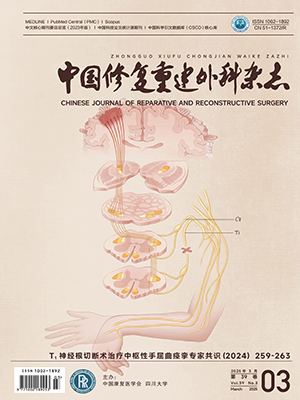Objective To compare the cl inical results between high-flexion and standard cruciate-stabling prostheses in total knee arthroplasty (TKA) by using the 36-item short form health survey (SF-36). Methods Between August 2007 and January 2009, 98 patients (106 knees) underwent TKA with standard cruciate-stabl ing prostheses (standard group), and 46 patients (50 knees) underwent TKA with high-flexion prostheses (high-flexion group). In standard group, there were
30 males (32 knees) and 68 females (74 knees) with an age of (70.0 ± 3.5) years, including 78 cases (82 knees) of osteoarthritis (OA) and 20 cases (24 knees) of rheumatoid arthritis (RA) with a disease duration of (14.5 ± 3.3) years; the Hospital for Special Surgery Scoring System (HSS) and the range of motion (ROM) were 56.1 ± 21.6 and (89.0 ± 16.1)°, respectively. In high-flexion group, there were 8 males (10 knees) and 38 females (40 knees) with an age of (68.6 ± 8.9) years, including 44 cases (47 knees) of OA and 2 cases (3 knees) of RA with a disease duration of (13.9 ± 4.1) years; the HSS and ROM were 58.9 ± 25.3 and (91.0 ± 19.3)°, respectively. There was no significant difference in the general data (P gt; 0.05) between 2 groups, so the cl inical data of 2 groups had comparabil ity. Results In standard group, poor wound heal ing and persistent headache caused by cerebrospinal fluid leakage occurred in 1 case, respectively. In high-flexion group, transient common peroneal nerve palsy occurred in 1 case. There was significant difference (P lt; 0.05) in the hospital ization expense between standard group [ (39 000 ± 6 000)] and highflexion goup [ (52 000 ± 8 000)]. The follow-up time was 12-26 months (18 months on average) in standard group (91 cases, 98 knees) and 11-19 months (13 months on average) in high-flexion group (44 cases, 47 knees). The SF-36 showed significant difference in role-physical score (P lt; 0.05), but no significant difference in other 7 indices scores (P gt; 0.05). At the final follow-up, the ROM was (129.1 ± 19.2)° in high-flexion group and (123.6 ± 16.7)° in standard group; showing significant difference (P lt; 0.05). The HSS was 91.2 ± 17.6 in high-flexion group and 92.5 ± 14.5 in standard group; showing no significant difference (P gt; 0.05). Conclusion After TKA, the ROM in high-flexion group is superior to that in standard group, but there is no obvious advantages in terms of the HSS and SF- 36 outcomes.
Citation: HONG Hangang,FANG Rui,SONG Yucheng,MENG Qingcai,JIA Heng,DENG Yingjie,LIANG Zhiquan.. COMPARISON OF CLINICAL RESULTS BETWEEN HIGH-FLEXION AND STANDARD CRUCIATE-STABLING PROSTHESES IN TOTAL KNEE ARTHROPLASTY. Chinese Journal of Reparative and Reconstructive Surgery, 2010, 24(9): 1062-1065. doi: Copy
Copyright © the editorial department of Chinese Journal of Reparative and Reconstructive Surgery of West China Medical Publisher. All rights reserved




